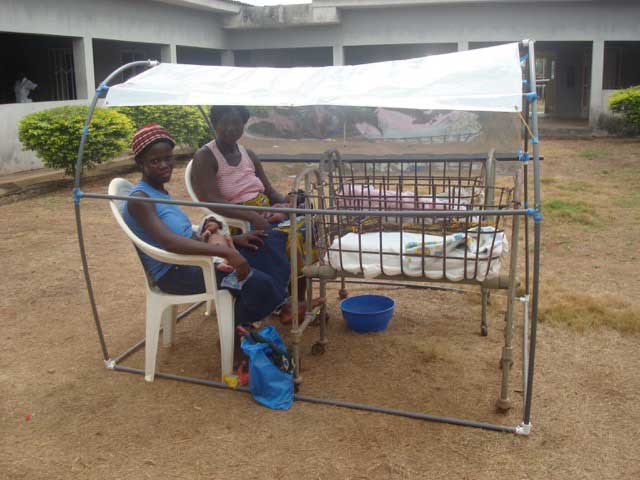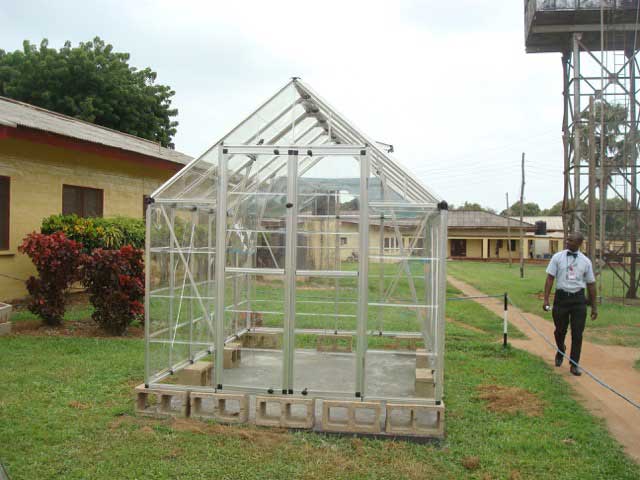Filtered Sunlight a Safe, Low-Tech Treatment for Newborn Jaundice
Safe sunlight exposure under canopies that remove harmful rays is a low-cost, effective way to give phototherapy to jaundiced infants in impoverished settings, according to a new study
For Release: September 16, 2015
Newborn jaundice can be treated with filtered sunlight, providing a safe, inexpensive, low-tech solution to a health problem that now causes permanent brain damage or death in more than 150,000 babies in developing countries each year.
That’s the finding of a new study by researchers at the Stanford University School of Medicine and their colleagues that will be published Sept.17 in The New England Journal of Medicine. In the study, conducted in Nigeria, some mothers and babies sat under outdoor canopies that filtered out harmful wavelengths from sunlight, but still allowed jaundice-treating blue wavelengths to reach the babies’ skin. The filtered-sunlight treatment was as safe and effective as the blue-light lamps traditionally used to treat infant jaundice.
“This research has the potential for global impact,” said the study’s senior author, David Stevenson, MD, the Harold K. Faber Professor in Pediatrics and senior associate dean for maternal and child health at Stanford. “All babies can get jaundice. In settings with no access to modern devices, we’ve shown we can use something that’s available all around the planet — sunlight — to treat this dangerous condition.” Stevenson also directs the Johnson Center for Pregnancy and Newborn Services at Lucile Packard Children’s Hospital Stanford.
Jaundice is extremely common in newborns, whose bodies need a few days after birth to develop the enzymes that enable excretion of bilirubin, a compound released during the normal breakdown of red blood cells. If too much bilirubin builds up in the blood, the skin and eyes acquire the hallmark yellow tinge of jaundice. Worse, high bilirubin levels can cause lasting brain damage or infant death.
 In 2010, Nigerian mothers and their infants sat below a 2010 prototype of a sunlight-filtering canopy. The structure filters out the sun's harmful wavelengths, allowing blue wavelengths to reach the skin of infants with jaundice. Courtesy of Hendrik Vreman.
In 2010, Nigerian mothers and their infants sat below a 2010 prototype of a sunlight-filtering canopy. The structure filters out the sun's harmful wavelengths, allowing blue wavelengths to reach the skin of infants with jaundice. Courtesy of Hendrik Vreman.
Filtering out ultraviolet, infrared rays
Phototherapy with lamps that emit blue wavelengths has been the most prevalent newborn jaundice treatment since the 1960s. But hospitals and health clinics in developing countries often lack the funds, expertise and reliable electricity needed to use the equipment.
The research team built and tested outdoor canopies that used commercially available plastic films to filter out sunburn-causing ultraviolet rays and infrared rays that could make infants overheat. Jaundice-treating blue wavelengths could pass through the filters. The team used different canopies for sunny and overcast days.
“Even with an overcast sky, we still get good light transmission and phototherapy,” said study author Hendrik Vreman, PhD, a senior research scientist in pediatrics at Stanford, who developed, built and tested the canopies.
For a clinical trial, the scientists enrolled 447 infants with jaundice at a large, inner-city hospital in Lagos, Nigeria, of whom 224 were randomly assigned to treatment with filtered sunlight and 223 to conventional phototherapy. Infants received at least five hours per day of their assigned treatment, and were evaluated hourly during treatment for signs of hypothermia, overheating, dehydration and sunburn. Infants treated with filtered sunlight were held in their mothers’ laps under the canopies and could breastfeed while receiving treatment.
 This year, a next-generation light house for delivering filtered-sunlight phototherapy was placed on the grounds of Bowen University Teaching Hospital in Ogbomoso, Nigeria. Courtesy of Hendrik Vreman.
This year, a next-generation light house for delivering filtered-sunlight phototherapy was placed on the grounds of Bowen University Teaching Hospital in Ogbomoso, Nigeria. Courtesy of Hendrik Vreman.
New, conventional methods similarly effective
The two therapies worked similarly well: Filtered sunlight was effective on 93 percent of treatment days, and conventional phototherapy on 90 percent of treatment days. The treatments were also similarly safe.
The team is now studying greenhouse-like structures that incorporate the filters. Such structures will allow for filtered-sunlight therapy in locations that are windy, rainy or have colder climates than Nigeria’s.
“We’re excited that we can use our understanding of the biology of jaundice and adapt treatment to the local context of a developing country, and the resources that exist there,” said Stevenson, who is a member of the Stanford Child Health Research Institute.
The study’s lead author is Tina Slusher, MD, associate professor of pediatrics at the University of Minnesota. Another Stanford-affiliated author of the study is Ronald Wong, senior research scientist in pediatrics.
Researchers at the University of Minnesota, Massey Street Children’s Hospital in Lagos and the University of California-San Diego also contributed to the study.
The study was funded by the Thrasher Research Fund and by the National Center for Advancing Translational Sciences of the National Institutes of Health (grant UL1TR000114.)
Stanford’s Department of Pediatrics also supported the work.
Authors
Erin Digitale
(650) 724-9175
digitale@stanford.edu
About Stanford Medicine Children's Health
Stanford Medicine Children’s Health, with Lucile Packard Children’s Hospital Stanford at its center, is the Bay Area’s largest health care system exclusively dedicated to children and expectant mothers. Our network of care includes more than 65 locations across Northern California and more than 85 locations in the U.S. Western region. Along with Stanford Health Care and the Stanford School of Medicine, we are part of Stanford Medicine, an ecosystem harnessing the potential of biomedicine through collaborative research, education, and clinical care to improve health outcomes around the world. We are a nonprofit organization committed to supporting the community through meaningful outreach programs and services and providing necessary medical care to families, regardless of their ability to pay. Discover more at stanfordchildrens.org.
About Stanford University School of Medicine
The Stanford University School of Medicine consistently ranks among the nation’s top medical schools, integrating research, medical education, patient care and community service. For more news about the school, please visit med.stanford.edu/school. The medical school is part of Stanford Medicine, which includes Stanford Health Care and Stanford Medicine Children’s Health. For information about all three, please visit med.stanford.edu.
Connect with us:
Download our App: